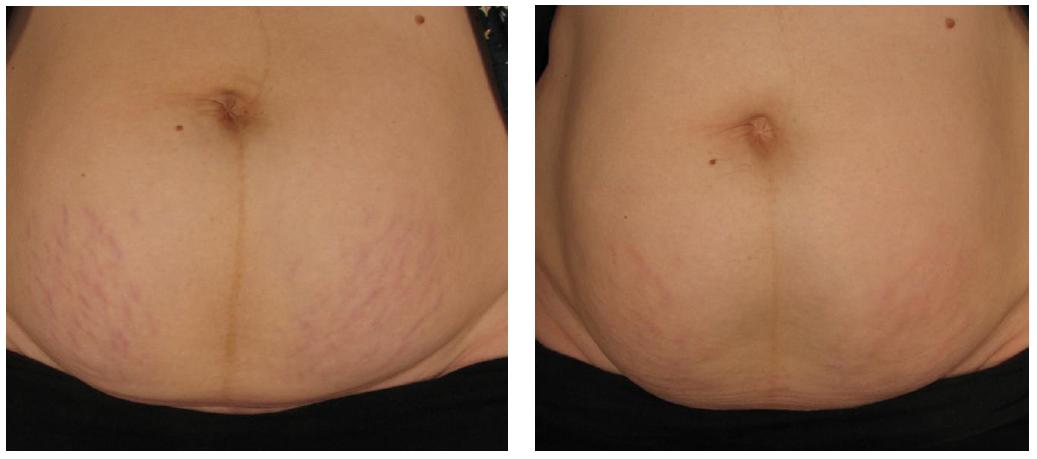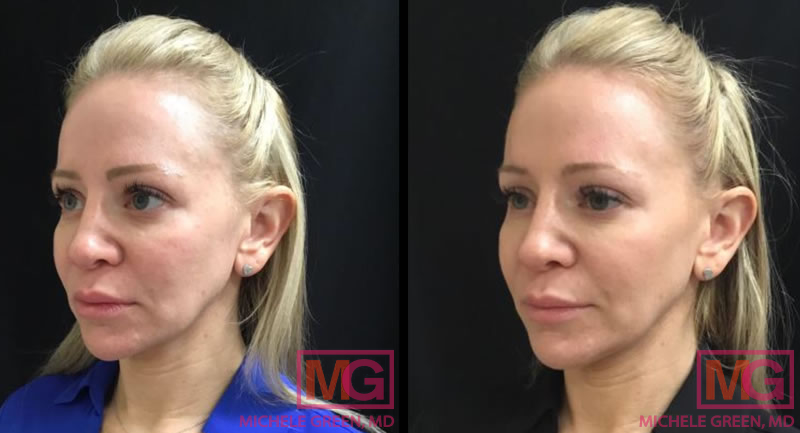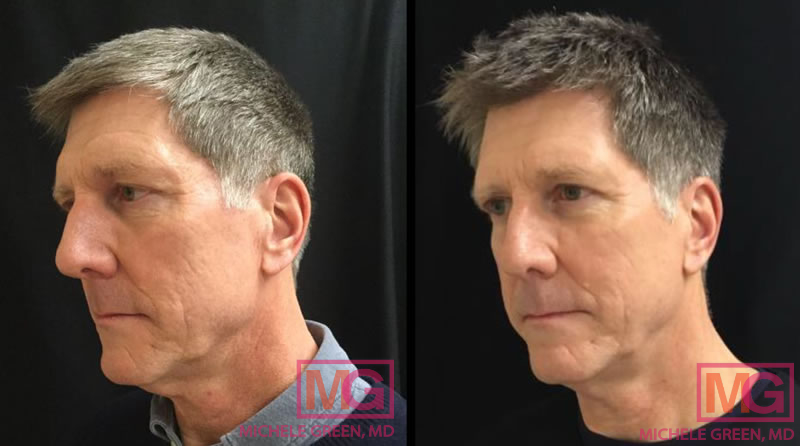Carbon Dioxide Laser (CO2 Laser)
The Carbon Dioxide Laser – also known as CO2 laser – is an ablative laser that uses a targeted laser beam emission of wavelength 10,600 nanometers to remove the outer layer of skin, treating various skin conditions. This safe and effective laser skin resurfacing treatment can be used for medical and cosmetic purposes, removing cancerous lesions, reducing the appearance of fine lines, wrinkles, and hyperpigmentation due to sun damage, and eliminating acne scars for total facial rejuvenation without the need for plastic surgery. A high-power laser that can be used both as an ablative laser and a fractional laser, the Carbon Dioxide laser causes controlled micro-wounds at the treatment site, triggering the body’s natural healing process and boosting the production of the structural protein collagen for improved skin tone and texture with only minimal downtime necessary. When looking to begin CO2 laser treatment, finding a healthcare provider experienced in laser surgery, such as New York City board-certified dermatologist Dr. Michele Green is essential.
As we age, signs of the passage of time will begin to show on the skin. As the production of the structural proteins collagen and elastin naturally decreases, skin laxity increases, making the appearance of fine lines and wrinkles more prominent. Over time, sun exposure can lead to pigmentation or discoloration in the form of sun spots or age spots that appear most commonly on the face, neck, and hands. Acne scars can mark the skin’s surface long after an initial breakout, leading to uneven skin texture and tone. Many laser treatments can help reduce the signs of aging, but the CO2 laser produces some of the most dramatic results while requiring minimal downtime.
Board-certified dermatologist Dr. Michele Green has treated patients in her Upper East Side New York City dermatology office for over 25 years. Experienced in various types of laser systems, Dr. Green is an expert in ablative laser treatments, such as the CO2 laser or Er: YAG laser, and non-ablative lasers, such as radiofrequency and intense pulsed light lasers. Regarding facial rejuvenation, Dr. Green often combines chemical peels, dermabrasion, Botox, dermal fillers, and Microneedling to achieve a full anti-aging effect. Well-known for high patient satisfaction, Dr. Green has been voted one of the best healthcare providers in New York City by such publications as New York Magazine, Castle Connolly, and Super Doctors.

What is CO2 laser resurfacing?
CO2 laser resurfacing is an ablative laser treatment that vaporizes the outer layer of skin, known as the epidermis, which boosts collagen production and increases the skin cell turnover rate for total facial rejuvenation. First invented in 1964 by Kumar Patel, the CO2 laser is one of the first treatments to become widely available and is still used frequently. The CO2 laser emits a mid-infrared beam of laser energy in a continuous wave at 10,600 nanometers, making it one of the highest output power lasers available for use. The CO2 laser can either be used as an ablative laser, which provides dramatic vaporization of the epidermis, or as a fractional laser, a gentler form of facial rejuvenation. Ablative or fractional lasers, such as the CO2 laser, are safest when used on patients with Fitzpatrick skin type I or II, as patients with darker skin are more susceptible to serious side effects, such as post-inflammatory hyperpigmentation or hypopigmentation.
How do CO2 lasers work?
The CO2 laser works via the emission of high-power Ultrapulse continuous wave energy beams that remove the outer layer of skin for a complete resurfacing effect. The CO2 laser device is composed of a mirrored resonator enclosing a gas mixture that, when fired, excites such gases as CO2. The laser-cutting process begins with the short Ultrapulses of light energy, which water in the skin absorbs. This high temperature of the pulses causes the water to vaporize, causing the outer layer of the skin to be removed and leading to increased skin cell turnover. Once the epidermis is vaporized, the dermal layer of skin also sustains controlled heat damage, triggering the body’s natural healing response and boosting collagen production at the treatment site. The new skin produced at the treatment site is more even in tone and texture with higher elasticity.
What do CO2 lasers do?
CO2 lasers cause controlled damage to the outer and inner layers of skin to improve the appearance of the skin. Carbon dioxide lasers are a great anti-aging treatment option as the micro-wounds caused by the laser emissions increase production of the structural proteins collagen and elastin, which helps to improve skin elasticity and reduce the appearance of fine lines and wrinkles. The vaporization of the outer layer of skin effectively destroys hyperpigmentation found at the treatment area, promoting skin cell turnover for a more even skin tone and texture. CO2 lasers treat acne scars similarly by stimulating skin cell turnover to reveal new, smooth skin. As the CO2 laser takes advantage of the body’s natural healing process, the treatment results continue to improve over time as collagen production naturally increases.
What are CO2 lasers used for?
CO2 lasers can be used to treat various skin conditions, including:
- Sun damage in the form of age spots or discoloration
- Fine lines and wrinkles
- Acne scars
- Chickenpox scars
- Mild injury or surgical scars
- Warts
- Sagging skin
- Uneven skin texture
- Hyperpigmentation
- Stretch marks
- Cancerous or pre-cancerous lesions

How CO2 laser treatments work
The first step in the CO2 laser treatment procedure is to seek out and consult with an experienced, board-certified dermatologist, such as Dr. Green. She will start by examining the treatment area and discussing your aesthetic goals to determine if CO2 laser resurfacing is your best treatment option. During your consultation, always disclose your medical history with Dr. Green, as patients with a history of herpes or shingles should not undergo carbon dioxide laser treatment. If the CO2 laser is a part of your treatment plan, Dr. Green will advise patients to avoid sun exposure in the four weeks leading up to the procedure and refrain from smoking in the weeks before, as smoking can slow down the healing process.
When you arrive at Dr. Green’s office for the carbon dioxide laser treatment, she will clean the skin and apply topical anesthesia to the treatment area. Depending on the size and scope of the treated area, the procedure can take between 30 minutes and two hours to complete. Some pain can be expected from the process, particularly when undergoing ablative CO2 laser treatment. Dr. Green will increase patient comfort by administering topical or general anesthesia, depending on how extensive the treatment is and the depth of laser penetration. Patients will also be given protective eyewear to shield the eyes from the laser beams. When the treatment has been performed, Dr. Green may supply patients with an icepack before dressing the treated area in a non-stick dressing that should be left on the skin for 24 hours post-treatment.
Dr. Green will provide patients with full aftercare instructions to be performed in the 2-4 weeks it takes the skin to heal fully from the carbon dioxide laser treatment. Following the treatment, patients often experience redness, swelling, and irritation at the treatment site, which is expected while the new skin forms. Patients must avoid sun exposure while the skin is healing by staying inside during peak hours and applying sunscreen whenever they go outside. In the days following the procedure, patients should also avoid strenuous activity and scratching, itching, and picking the skin at the treatment site. Following Dr. Green’s aftercare instructions and attending all scheduled follow-up appointments should help avoid serious adverse events.

Is the CO2 laser dangerous?
The CO2 laser has been used to treat patients for over 50 years. It is considered a safe and effective treatment for various skin conditions, including acne scars, fine lines, wrinkles, sun damage, pre-cancerous lesions, warts, and hyperpigmentation. Due to the ablative nature of the laser treatment, the CO2 laser can be dangerous for patients with Fitzpatrick skin type III-VI, as patients with darker skin tones are at a higher risk for developing post-inflammatory hyperpigmentation or laser burns. Dr. Green has many options for patients with darker skin that are effective at anti-aging treatment while being gentle and safe for Skin of Color.
In any patient being treated with the CO2 laser, the common side effects of treatment include:
- Redness or discoloration at the treatment site
- Irritation and itchiness
- A burning sensation like that of a mild sunburn
- Scabbing, peeling, or dryness
- Increase photosensitivity
More serious adverse events can occur, including the development of milia, which are small white bumps on the skin, acne breakouts, scarring, infection, hyperpigmentation, and laser burns. However, the risk of developing severe side effects significantly decreases when seeking treatment from an expert dermatologist, such as Dr. Green.
Is the CO2 laser permanent?
The CO2 laser resurfaces the skin by vaporizing the outer layer of the skin to promote skin cell turnover and trigger the body’s natural healing response. This helps to erase signs of the natural aging process, such as fine lines, wrinkles, age spots, acne scars, and hyperpigmentation. When eliminating the appearance of pigmentation on the skin, CO2 laser resurfacing will permanently destroy the hyperpigmentation. However, future sun exposure or other environmental factors could lead to the development of new discoloration down the line, which is why patients should always practice strict sun avoidance. The appearance of fine lines and wrinkles may be improved by CO2 laser treatment, but collagen production will again decrease, and lines will become etched into the face. However, many anti-aging treatments available at Dr. Green’s office can be performed to maintain evenly textured, youthful-looking skin.
What is the CO2 resurfacing laser?
The CO2 resurfacing laser is an ablative laser treatment that can repair sun-damaged skin, even out skin tone and texture, erase fine lines and wrinkles, eliminate warts, and reduce the appearance of acne scars. To do so, the CO2 laser contains a gas mixture and resonator that emits laser energy to vaporize the skin’s outer layer and penetrate the dermal layer. While the outer layer is destroyed, allowing new, clear skin to form, the dermal layer heats up to trigger the body’s natural healing response, increasing collagen production and tightening the skin.

What are fractional CO2 lasers?
Two types of CO2 lasers are available: fractional CO2 lasers and ablative CO2 lasers, each effective for different skin conditions. Fractional lasers release light energy as many targeted beams penetrate the inner layer of skin while leaving the surrounding tissue unharmed. The fractional CO2 laser is advantageous because it targets specific treatment sites precisely, decreasing the downtime and recovery time necessary. However, the fractional CO2 laser is less potent than the ablative CO2 laser and cannot produce the same dramatic results. Ablative CO2 lasers differ from fractional CO2 lasers in how the beams of laser energy are directed. Where fractional lasers target precise areas of the skin, the ablative CO2 lasers fully vaporize the epidermal layer of skin to produce full resurfacing of the treatment area. While the recovery time is longer, the effects of the treatment are more visible.
Where can CO2 lasers be used?
CO2 laser treatment is often used on the face but can also treat hyperpigmentation, uneven skin texture, wrinkles, skin laxity, and scarring on the hands, arms, and neck. When you have your initial consultation with Dr. Green, she will examine the treatment area and decide the best treatment option. Some patients may require complete facial rejuvenation, while others will only need treatment for a small portion. CO2 laser treatment can be paired with other anti-aging treatments, such as Botox, dermal fillers, or chemical peels, depending on the cosmetic concern. The time needed for the treatment to be performed and the total cost of the treatment will depend on these factors.
Why the CO2 laser?
The CO2 laser is one of the most commonly used ablative lasers and has been used to treat patients for facial resurfacing since 1964. Long deemed safe and effective for use on patients with Fitzpatrick skin types I and II, the CO2 laser can address various skin conditions, including fine lines, acne scars, hyperpigmentation, warts, high skin laxity, and cancerous lesions. The CO2 ablative laser is more potent than non-ablative lasers, providing patients with dramatic and visible results with some downtime required. However, it is not as invasive as plastic surgery, making it an excellent middle ground between the two. Used on the fractional laser setting, the CO2 laser can also target precise treatment areas without damaging the surrounding tissue.
Is the CO2 laser worth it?
The carbon dioxide laser is a safe and effective treatment for skin rejuvenation and treating various skin conditions. In all of the years that laser treatment has been available for patients, much research has been conducted on the effectiveness of the treatment. In addition to treating fine lines, wrinkles, hyperpigmentation, and uneven skin texture, in a 2018 study, researchers found that CO2 laser treatment is very effective at reducing the appearance of acne scars, particularly when combined with Microneedling. In 2015, researchers determined that, when using the fractional laser setting, the carbon dioxide laser resurfacing treatment also effectively eliminates the appearance of post-burn scars. The CO2 laser can even remove pre-cancerous or cancerous lesions from the skin, making it a safe and effective cancer treatment option.
How to get started with CO2 laser treatment today?
As we age, the production of the structural proteins collagen and elastin naturally decreases, leading to higher skin laxity, the development of fine lines and wrinkles, and the increased appearance of sun damage on the skin. Some patients may struggle with uneven skin texture and tone due to age spots or acne scars, which can mark the skin with small depressions. Luckily, many non-invasive treatment options for rejuvenation are available at the private dermatology office of Dr. Michele Green in the Upper East Side neighborhood of New York City.
Dr. Michele Green is an internationally renowned board-certified cosmetic dermatologist with over two and a half decades of experience providing some of the world’s most discerning individuals with the best non-invasive treatment options available, including laser skin resurfacing. She is consistently identified as one of New York’s best dermatologists by Castle Connolly, New York Magazine, and Super Doctors for her dedication to her patients and expertise. When you consult Dr. Green for your rejuvenation treatment plan, she will work with you to select the non-invasive treatment options best suited to your specific skin concerns and aesthetic goals for long-lasting, natural-looking rejuvenation results. To schedule a consultation with Dr. Green and learn more about the CO2 laser and other skin rejuvenation treatment options, call the NYC-based office at 212 535 3088 or contact us today.
 212-535-3088
212-535-3088 